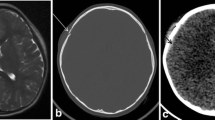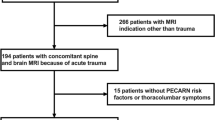Abstract
Background
In the evaluation of children younger than 3 years with intracranial hemorrhage it can be difficult to determine whether the cause of hemorrhage was traumatic, and if so, whether abusive head trauma (AHT) is a possibility. Cervical spine MRI is not a routine part of the nationally recommended imaging workup for children with suspected abusive head trauma. There is increasing evidence that spinal injuries are found at autopsy or MRI in abused children. However the prevalence of cervical spine injuries in children evaluated for abusive head trauma is unknown. We sought to determine both the incidence and the spectrum of cervical spine and brain injuries in children being evaluated for possible abusive head trauma. We also examined the relationship between cervical and brain MRI findings and selected study outcome categories.
Materials and methods
This study is a 3-year retrospective review of children evaluated for abusive head trauma. Inclusion criteria were: children with head trauma seen at our institution between 2008 and 2010, age younger than 36 months, availability of diagnostic-quality brain and cervical spine MRI, and child abuse team involvement because abusive head trauma was a possibility. A child abuse pediatrician and pediatric radiologists, all with board certification, were involved in data collection, image interpretation and data analysis. Statistical analysis was performed using Stata v12.1.
Results
The study included 74 children (43 boys, 31 girls) with a mean age of 164 days (range, 20–679 days). Study outcomes were categorized as: n = 26 children with accidental head trauma, n = 38 with abusive head trauma (n = 18 presumptive AHT, n = 20 suspicious for AHT), and n = 10 with undefined head trauma. We found cervical spine injuries in 27/74 (36%) children. Most cervical spine injuries were ligamentous injuries. One child had intrathecal spinal blood and two had spinal cord edema; all three of these children had ligamentous injury. MRI signs of cervical injury did not show a statistically significant relationship with a study outcome of abusive head trauma or help discriminate between accidental and abusive head trauma. Of the 30 children with supratentorial brain injury, 16 (53%) had a bilateral hypoxic–ischemic pattern. There was a statistically significant relationship between bilateral hypoxic–ischemic brain injury pattern and abusive head trauma (P < 0.05). In addition, the majority (81%) of children with bilateral hypoxic–ischemic brain injuries had cervical injuries.
Conclusion
Although detection of cervical spine injuries by MRI does not discriminate between accidental and abusive head trauma, it can help to distinguish a traumatic from non-traumatic intracranial subdural hemorrhage. Cervical MRI should be considered in children with acute intracranial bleeds and otherwise non-contributory history, physical examination and ophthalmological findings. There is a statistically significant relationship between diffuse hypoxic–ischemic brain injury patterns and abusive head trauma. The high incidence of cervical injuries in children with hypoxic–ischemic injuries suggests a causal relationship. Overall, increased utilization of brain and spine MRI in children being evaluated for abusive head trauma can be helpful.










Similar content being viewed by others
References
Hymel KP, Jenny C, Block RW (2002) Intracranial hemorrhage and rebleeding in suspected victims of abusive head trauma: addressing the forensic controversies. Child Maltreat 7:329–348
Kemp AM (2002) Investigating subdural haemorrhage in infants. Arch Dis Child 86:98–102, Review
Hettler J, Greenes DS (2003) Can the initial history predict whether a child with a head injury has been abused? Pediatrics 111:602–607
Boos SC, Feldman K (2011) Neck and spinal cord injuries in child abuse. In: Child abuse and neglect: diagnosis, treatment and evidence, 1st edn. Saunders, St. Louis, pp 396–398.
Choudhary AK, Bradford RK, Dias MS et al (2012) Spinal subdural hemorrhage in abusive head trauma: a retrospective study. Radiology 262:216–223
Kemp AM, Joshi AH, Mann M et al (2010) What are the clinical and radiological characteristics of spinal injuries from physical abuse: a systematic review. Arch Dis Child 95:355–360
Brennan LK, Rubin D, Christian CW et al (2009) Neck injuries in young pediatric homicide victims. J Neurosurg Pediatr 3:232–239
Duhaime AC, Alario AJ, Lewander WJ et al (1992) Head injury in very young children: mechanisms, injury types, and ophthalmologic findings in 100 hospitalized patients younger than 2 years of age. Pediatrics 90:179–185
Foerster BR, Petrou M, Lin D et al (2009) Neuroimaging evaluation of non-accidental head trauma with correlation to clinical outcomes: a review of 57 cases. J Pediatr 154:573–577
Anderson SE, Boesch C, Zimmermann H et al (2012) Are there cervical spine findings at MR imaging that are specific to acute symptomatic whiplash injury? A prospective controlled study with four experienced blinded readers. Radiology 262:567–575
Brockmeyer DL, Ragel BT, Kestle JR (2012) The pediatric cervical spine instability study. A pilot study assessing the prognostic value of four imaging modalities in clearing the cervical spine for children with severe traumatic injuries. Childs Nerv Syst 28:699–705
Schoenwaelder M, Maclaurin W, Varma D (2009) Assessing potential spinal injury in the intubated multitrauma patient: does MRI add value? Emerg Radiol 16:129–132
Goradia D, Linnau KF, Cohen WA et al (2007) Correlation of MR imaging findings with intraoperative findings after cervical spine trauma. AJNR Am J Neuroradiol 28:209–215
Jenny C, Hymel KP, Ritzen A et al (1999) Analysis of missed cases of abusive head trauma. JAMA 282:621–629
Ichord RN, Naim M, Pollock AN et al (2007) Hypoxic–ischemic injury complicates inflicted and accidental traumatic brain injury in young children: the role of diffusion-weighted imaging. J Neurotrauma 24:106–118
Geddes JF, Vowles GH, Hackshaw AK et al (2001) Neuropathology of inflicted head injury in children. II. Microscopic brain injury in infants. Brain 124:1299–1306
Zimmerman RA, Bilaniuk LT, Farina L (2007) Non-accidental brain trauma in infants: diffusion imaging, contributions to understanding the injury process. J Neuroradiol 34:109–114
Chan YL, Chu WC, Wong GW et al (2003) Diffusion-weighted MRI in shaken baby syndrome. Pediatr Radiol 33:574–577
Cantu RC, Gean AD (2010) Second-impact syndrome and a small subdural hematoma: an uncommon catastrophic result of repetitive head injury with a characteristic imaging appearance. J Neurotrauma 27:1557–1564
McKinney AM, Thompson LR, Truwit CL et al (2008) Unilateral hypoxic–ischemic injury in young children from abusive head trauma, lacking craniocervical vascular dissection or cord injury. Pediatr Radiol 38:164–174
Koumellis P, McConachie NS, Jaspan T (2009) Spinal subdural haematomas in children with non-accidental head injury. Arch Dis Child 94:216–219
Conflict of interest
None
Author information
Authors and Affiliations
Corresponding author
Rights and permissions
About this article
Cite this article
Kadom, N., Khademian, Z., Vezina, G. et al. Usefulness of MRI detection of cervical spine and brain injuries in the evaluation of abusive head trauma. Pediatr Radiol 44, 839–848 (2014). https://doi.org/10.1007/s00247-014-2874-7
Received:
Revised:
Accepted:
Published:
Issue Date:
DOI: https://doi.org/10.1007/s00247-014-2874-7




